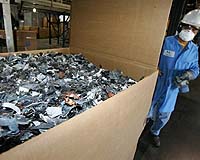| . |  |
. |
Edmonton, Canada (SPX) Sep 02, 2010 Inorganic elements known to be toxic at low concentrations are being discharged to air and water by oilsands mining and processing according to University of Alberta (U of A) research findings being published this month in one of the world's top scientific journals. The 13 elements being discharged include mercury, arsenic, lead, cadmium and several other metals known to be toxic at trace levels. The paper will appear in the August 30 edition of the Proceedings of the National Academy of Sciences (PNAS). The results are not surprising according to corresponding author David Schindler - an internationally acclaimed researcher in the Department of Biological Sciences at the U of A - given the huge amounts of many of the same elements that the industry has reported discharging, according to Environment Canada's National Pollutant Release Inventory. "Given the large amounts of pollutants released, any monitoring program that cannot detect increases in the environment must be considered as incompetent," says Schindler, referring to the Regional Aquatic Monitoring Program. "The U of A study was deliberately designed to test claims by industry and Alberta politicians that all contaminants in the river are from natural sources," said Schindler. This included examining patterns of deposition of pollutants in snow and releases to water both near to, and remote from, industry. "Rather than pollutants increasing continuously downstream in the river due to natural sources, as government has claimed, concentrations of the majority of toxins were always highest near sites of industrial activity," Schindler says. He notes however that concentrations of many contaminants remained above background levels right up to the Athabasca Delta. Elevated concentrations were in Lake Athabasca, near Fort Chipewyan. "The releases are in clear violation of section 36, subsection 3 of the Fisheries Act, which prohibits discharge of toxins in any quantity into fish-bearing waters." Schindler says much of the debate over the impact of oilsands has been based on a combination of conjecture and propaganda, which has not been peer reviewed or published in recognized scientific publications. An earlier (December, 2009) paper by the research group documented the release by the oilsands industry of a number of organic carcinogens, similar to those released by the BP spill into the Gulf of Mexico, and the Exxon Valdez into the Gulf of Alaska.
Share This Article With Planet Earth
Related Links University of Alberta Our Polluted World and Cleaning It Up
 Scientists Concerned About Environmental Impact Of Recycling Of E-Waste
Scientists Concerned About Environmental Impact Of Recycling Of E-WasteCorvallis OR (SPX) Aug 31, 2010 Much of the world's electronic waste is being shipped to China for recycling and the cottage industry that has sprung up there to recover usable materials from computers, cell phones, televisions and other goods may be creating significant health and environmental hazards. Scientists from China and the United States have identified numerous toxic elements in the emissions from an e-waste r ... read more |
|
| The content herein, unless otherwise known to be public domain, are Copyright 1995-2010 - SpaceDaily. AFP and UPI Wire Stories are copyright Agence France-Presse and United Press International. ESA Portal Reports are copyright European Space Agency. All NASA sourced material is public domain. Additional copyrights may apply in whole or part to other bona fide parties. Advertising does not imply endorsement,agreement or approval of any opinions, statements or information provided by SpaceDaily on any Web page published or hosted by SpaceDaily. Privacy Statement |